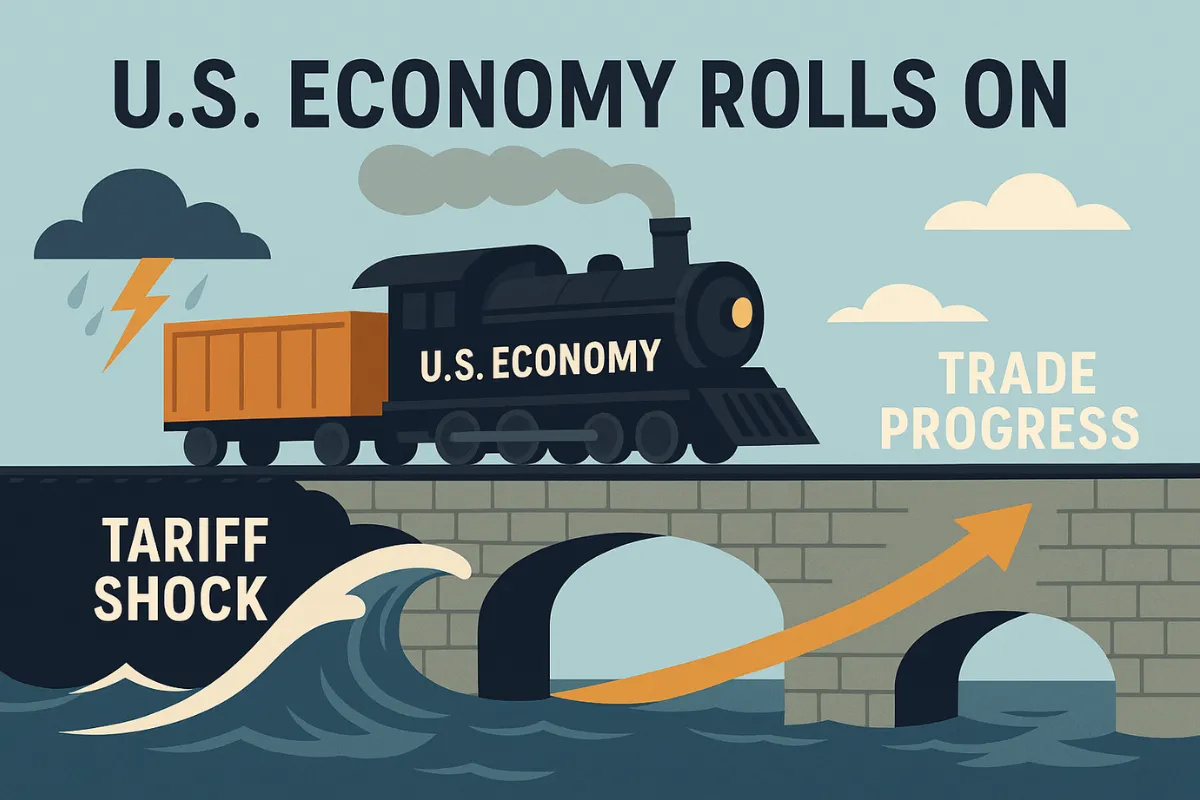BLOG

US Economy Roles On
This year, investors have been challenged to navigate market volatility that so far has been based more on speculation than facts about the economy. Since President Trump’s inauguration, he has rolled out more policies in these past 113 days than any president I can remember. Some policies, such as school vouchers, DOGE, immigration, and DEI, didn’t seem to change investor sentiment. However, on Wednesday, April 2, 2025, President Trump held a White House Rose Garden ceremony where he announced what he called his “reciprocal tariff” strategy. The new tariff policy sent shock waves throughout the world financial markets. The official White House Fact Sheet released on the same day stated:
“PURSUING RECIPROCITY TO REBUILD THE ECONOMY AND RESTORE NATIONAL AND ECONOMIC SECURITY: Today, President Donald J. Trump declared that foreign trade and economic practices have created a national emergency, and his order imposes responsive tariffs to strengthen the international economic position of the United States and protect American workers.”
The media, analysts, and institutional investors immediately interpreted this new policy as devastating for the future of the US economy, with speculations of recession or worse by the end of 2025. Institutional investors rocketed the futures market that night with aggressive selling, and the stock market plummeted the next three trading days, with the S&P 500 dropping -12.14% and NASDAQ -13.26%. Investors had already started the year selling AI and tech darling stocks that included Nvidia (NVDA), Apple (AAPL), Google (GOOG), Super Micro Computer (SMCI), Palantir (PLTR), and Arista (ANET). However, investor selling accelerated the day after President Trump’s tariff announcement.
During the following weeks, the major indices experienced wide ranges of daily fluctuation with the VIX (Volatility Index), a volatility fear gauge, soaring to its third-highest reading in 25 years.

Jump forward to this past weekend, as both US and China representatives announced significant progress with a trade agreement between the two powerhouse economies. The announcement has brought significant relief to institutional investors who have rallied the stock market this week.
As of today, of the six major US indices, only the small and mid-cap indices have not fully recovered from deep negative returns since the election day.

Since the presidential election, the stock market has had quite a wild ride. If President Trump’s goal is to keep investors on high alert, he certainly has accomplished that. In the short period since his election, the major indices have fluctuated significantly, with the small and mid-cap indices down as much as -22.35% and 18.85% respectively by April 8, 2025.
So, what can we learn from these past two months? First, President Trump's modus operandi of making outlandish statements and projections is simple. Outlandish. After all the stock market “disturbance” caused by his comments on tariffs and subsequent analysts' and major media commentaries, the actual outcome of this issue has so far resulted in reasonably acceptable terms. President Trump's announcements from the Rose Garden were considered unthinkable levies on about 90 nations, including China and Canada. This and subsequent tariff announcements created tremendous uncertainty and stock market volatility for almost two months. It may be the way for the administration to get the tariff agreements with China, but it was a rough experience for investors.
Investors can breathe a sigh of relief…for now.
Dispelling outlandish statements causing uncertainty was the same scenario during President Trump’s first term. Initially, investors were optimistic about the Trump administration and rallied the major indices in 2017. However, investors' optimism waned in 2018 due to uncertainty of the economy fueled by President Trump's trade wars with China and the concerns that the Federal Reserve was raising the discount rate too quickly. PBS reported on December 27, 2018, the following explanation for the huge selloff in late 2018:
“The Trump administration’s tariffs on imported aluminum, steel, and other goods have introduced a large amount of uncertainty into the global economy. In May, Trump decided not to spare any country, including U.S. allies, from the steel and aluminum tariffs. The trade war, which has centered on China, continued to escalate until Trump and China’s President Xi Jinping agreed earlier this month to hold off on imposing new tariffs for 90 days…..The stock market woes come despite signs that the general economy is still doing well.”
In addition to trade war rhetoric, the Federal Reserve raised its discount rate four times in 2018, which prompted investor concerns of a recession. From August 30, 2018, to December 24, 2018, the major indices plunged, with the S&P 500 dropping -20% and the NASDAQ dropping by 27%.
After the significant selloff in late 2018, investors' optimism was renewed as trade tensions de-escalated and the Federal Reserve adopted a “wait and see” posture on inflation. Technology remained a strong growth sector. For 2019, the S&P 500 rallied 28.9% and NASDAQ 35.2% that continued into 2020 after the first quarter short-lived coronavirus panic selloff.
All major averages ended in the positive during President Trump’s first term, with NASDAQ leading, helped by a significant 2020 rally. Below are the cumulative returns of the major indices during President Trump’s entire first term from January 17, 2017, to January 20, 2021:
NASDAQ: 143.00%
S&P 500: 69.80%
DJIA: 57.30%
MSCI ex US: 52.01%
S&P 600: 48.45%
S&P 400: 47.60%
S&P Bond: 28.30%

What Does This Mean to Me?
Despite all the stock market volatility, the US economy continued to expand, more people were hired, inflation stayed within the Federal Reserve's acceptable range, and companies still have over 7 million job opportunities.
Donald Trump has been president for a whopping 113 days, which already seems like a lifetime. There is no reason to expect anything different in his messaging and process going forward. In hindsight, during his first term, investors should have invested aggressively at the worst of times. Although it is hard to pick tops in the market, it is easier to enter new investments once stock prices are well below previous high points.
Many leading tech and AI stocks are still below their previous all-time highs, reached earlier this year. In hindsight, the best buying opportunity through this recent cycle was on April 9. However, that would have been for the speculative investors with no evidence on how the trade and tariff war would be resolved between China and the US. However, last week we began entering new deposits into the market primarily due to positive technical indications that institutional investors were slowly rebuilding their stock portfolios. Market conditions continue to improve this week, with tariff agreements between China and the US in the works. The VIX is back to levels of stability, and the major indices have closed down only three of the past 13 days.
Also, a bullish technical confirmation is that the S&P 500 is now back above its 20, 50, and 200-day moving Averages (DMA).

This is also true for NASDAQ.

Let us know your thoughts on today’s UPdate. We welcome the opportunity to assist you with your financial planning and navigating through these market cycles.
CONTACT
Check the background of your financial professional on FINRA's BrokerCheck.
The content is developed from sources believed to be providing accurate information. The information in this material is not intended as tax or legal advice. Please consult legal or tax professionals for specific information regarding your individual situation. The opinions expressed and material provided are for general information, and should not be considered a solicitation for the purchase or sale of any security.
We take protecting your data and privacy very seriously. As of January 1, 2020 the California Consumer Privacy Act (CCPA) suggests the following link as an extra measure to safeguard your data: Do not sell my personal information.
The information on this website is the opinion of Up Capital Management and does not constitute investment advice or an offer to invest or to provide management services. Before purchasing any investment, a prospective investor should consult with its own investment, accounting, legal, and tax advisers to evaluate independently the risks, consequences, and suitability of any investment.
Copyright 2024 | Privacy Policy | Terms & Conditions

